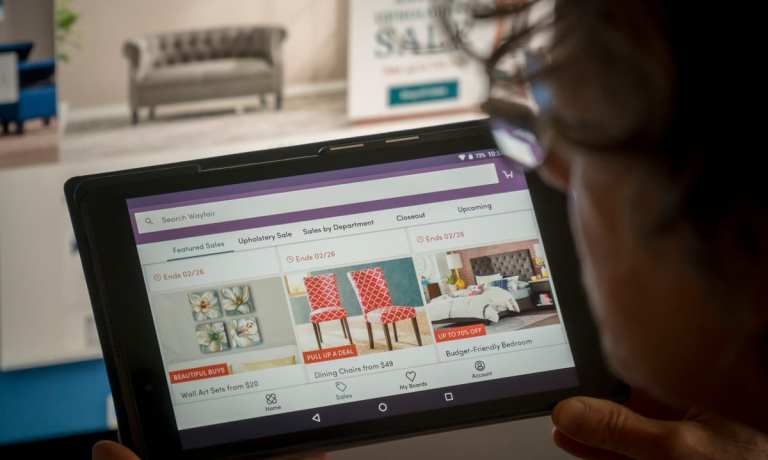Go home and stay home until we sound the all-clear, they said. So, we did.
Being Americans, always seeing new possibilities, it didn’t take long for work-from-home lockdowns to transmute into home improvement ideas. Office sheds started appearing in backyards, and folks began a top-down reorganization of living spaces on a painful, widespread belief that the pandemic will continue as a real threat for about 300 days more.
Calculating how long lockdown trendlines can continue before plateauing or falling off is now the fixation of most CEOs and CFOs, as they closely watch the progress of market-makers.
Bloomberg reported this week that Boston-based home décor eCommerce giant Wayfair turned in strong Q3 financials, noting that the firm’s quarterly results “exceeded analysts’ estimates, suggesting the wave of home improvement inspired by the COVID-19 pandemic is lingering.”
That’s the multi-billion-dollar question, as the home furnishings brands and merchants that have done well thanks to pandemic cocooning look ahead to next year and make post-COVID plans.
For its Q3, Wayfair gained 51 percent more active customers, rising to 28.8 million from a year earlier. “Shoppers are spending slightly less per order, at $243 compared with $252 during the same period a year ago,” reported Bloomberg.
Advertisement: Scroll to Continue
Included in those results is the fact that “repeat shoppers made 71.9 percent of overall orders in Q3 2020 in contrast to 67.3 percent in Q3 2019. Those repeat shoppers made 11.3 million orders in Q3 2020, marking a jump of 84.4 percent year over year,” as PYMNTS reported.
Being top-heavy in repeat customers who will have beautified every corner of their homes by December may or may not be a blessing when the COVID buying bubble inevitably bursts.
Wayfair sounds confident, however. CEO, Co-founder and Co-chairman Niraj Shah said that “in the midst of continued uncertainty about the economy and the pandemic, Wayfair delivered another quarter of strong operating and financial results in Q3.”
Unmasking What Happened
It’s strange to recall that all of this started with the mobilization of private industry to retool and crank out personal protective equipment (PPE) — primarily face masks — last spring. “It was like waking up and discovering it was Cyber Monday, except everyone in the world just wanted one product, and that product was in extremely limited supply,” noted Etsy CEO Josh Silverman on a call with investors over the summer.
For artisanal home goods marketplace Etsy, Q3 revenue rose 31.6 percent year over year, with gross profit up more than 24 percent. Revenue was $197.9 million for the quarter that just ended, including $6 million related to Etsy’s earlier purchase of used musical instrument site Reverb.
That comes after a busy summer, as PYMNTS reported that “in July, Etsy launched a smart pricing tool to give sellers the ‘tools, education and support they need’ to offer free shipping to U.S. buyers on orders of $35 or more. The company’s recent earnings results showed that, as of the end of Q3, 62 percent of items on the Etsy marketplace offered free shipping to U.S. buyers, and 74 percent of U.S. listing views were eligible to ship for free.”
Such enticements greased the gears of an eCommerce flywheel that scarcely needed it in 2020. Winter weather will end in six months, however. Big home improvement merchants and brands want to keep people feathering the nest. How they will accomplish this as the COVID threat dissipates is a key gambit of 2021.
Groceries, Smart Home Tech Hold Post-COVID Promise
Looking for clues as to which COVID-era changes will be permanent compared to those that will have been situational in hindsight, PYMNTS delved into the staying power of 2020 trends.
There are some certainties. For example, the October Pandenomics report notes that “the biggest change of all will likely be the share of consumers shopping for groceries online. Our research shows that 85.3 percent of consumers who have shifted to grocery shopping online plan to maintain at least some and possibly all of their new digital shopping habits, meaning that only 14.7 percent plan to resume shopping in physical grocery stores.”
People need to eat a few times a day, but one can only buy so many throw pillows. Put another way, lockdown chic will eventually fade. What may not fade is the desire to turn homes into ready-for-anything, multi-use, superconnected command centers. That bodes well not only for Wayfair, Etsy and, to a lesser extent, Amazon, but also for Big Tech’s home presence.
As Big Tech firms and streaming subscription services also turned in solid Q3 financials, PYMNTS reported that “earnings season represents a snapshot, a rearview mirror look at a specific three months. As we head into the all-important holiday season, a commerce landscape that may be marked by more lockdowns will certainly continue to bring eCommerce front and center.”

